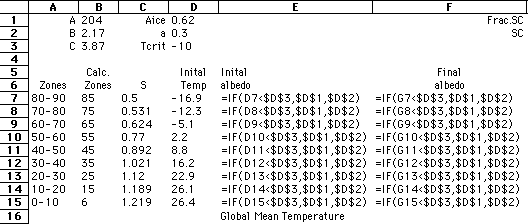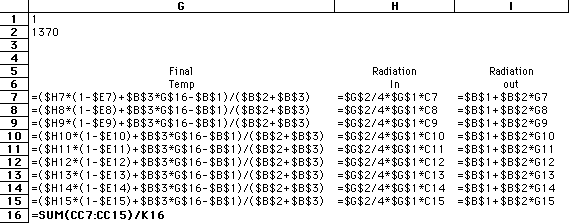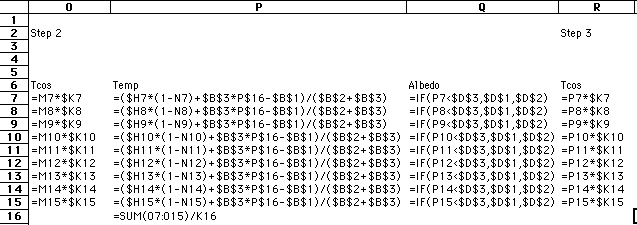|
This model can be built using virtually any computational tool. We have developed an interactive version using Perl 5. Spreadsheets are particularly well-suited for this case study. A programming language such as Fortran or C, or tools like Mathematica or MathCAD, also are suitable computing environments for this project.
In this case study, you have two options for studying the behavior of an energy balance model:
- build the model yourself using some appropriate computational tool. Formulas for building this using a spreadsheet are provided below.
- use the interactive model provided for you
- if you have access to the perl program, you can download the source code written in Perl 5.
For this model, you will need these input parameters:
- A, a constant that defines the longwave radiation loss, in units of watts meter-2
- B, another constant that defines the longwave radiation loss, in units of watts meter-2 degrees C-1
- C, the transport coefficient, in units of watts meter-2 degrees C-1
- the critical temperature, Tcrit, the temperature (in degrees Celsius) at which land becomes covered with snow and/or water turns to ice
- the latitude (in degrees North), which represents the middle of the zone (for example, 85 degrees north for the zone between 80-90 degrees North
- the initial surface temperature at a particular latitude, or zone
- S, the mean annual radiation (in watts) incident at a particular latitude
- the initial albedo at a particular latitude
There are fundamentally three sets of calculations that you will need to do this case study:
- Initial calculations of zonal temperature, surface albedo, and radiation in
- Iterative (looping, or repeating) calculations
- Final calculations of temperatures, albedoes, and radiation out
To see ONE way of solving this problem, you can look at "screensnaps" of a sample spreadsheet




Some of the experiments that can be done with this model are:
- At what fraction of the solar constant does the hemisphere "ice over", that is, the surface temperatures in all the zones fall to or below the critical temperature? How sensitive is the model to changes in the solar constant fraction?
- A variety of values for the transport constant has been reported:
- K=3.81 W m-2 C-1
- K=3.74 W m-2 C-1
- How sensitive is the model to changes in this constant?
- Holding A constant, vary B slightly and investigate the effect on the climate. What does a variation in B correspond to physically?
|

